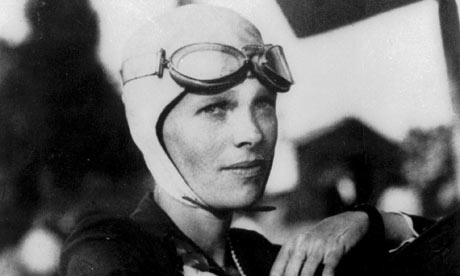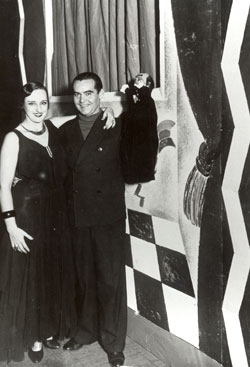The survey of the best classic film directors was overwhelming. Not a single vote for the filmmaker. I really do not deserve votes or is that no one knew? In the entrance and told and told and would devote its entry of justice. I promised.
Dorothy Arzner survey passed unnoticed but do you know that she was the inventor of the "giraffe".? When the actors of the 20 cast their sentences to a fixed microphone placed in front of the camera, she came up with the idea of \u200b\u200bhanging a microphone from a fishing rod and use it to follow the actors. The year was 1929.
Dorothy Arzner Arzner Dorothy was born on January 3, 1900 in San Francisco. He grew up surrounded by actors and filmmakers who frequented the "Hoffman Café" run by his father. One of his famous playmates was Charlie Chaplin.
wanted to be a doctor and drove an ambulance during the First World War. After leaving the university accepted his first job as a typesetter for film scripts. He soon began to cut and edit. He edited 52 films as an editor in chief RealArt, a subsidiary of Paramount studio.
directorial debut in 1927 for the same study and from that year until 1934 he directed 16 films for Paramount and for other studies as an independent director. Received much media attention because they are women, so that their work was watched very closely by the press.
Her films address controversial issues such as extramarital sex, pregnancy and relationships between people of different social classes. Some also saw "homoeroticism" in their movies. Dorothy Arzner is named in the book "Greta & Marlene . Sappho Goes to Hollywood ." That is why I knew of its existence. And from there I knew it I had seen a movie you and did not know, because one of my favorite actresses worked with her, Katharine Hepburn.
 Clara Bow and Marceline Day in The Wild Party 1929. In Spain it was called The Mad Orgy , I suppose that long after censorship.
Clara Bow and Marceline Day in The Wild Party 1929. In Spain it was called The Mad Orgy , I suppose that long after censorship. Other actresses who also worked with her were Claudette Colbert, Joan Crawford or Clara Bow.
In 1959 he went to the Department of Cinematography at the Drama section of the University of California-Los Angeles, as a teacher, where one student was Francis Ford Coppola .
Dorothy Arzner In 1933 he paid tribute to another woman, who "sneaked" into the world of called male professions, Amelia Earthart, an American aviator, famous for its flying brands and try the first voyage around the world on the equator. Katharine Hepburn was in charge of Amelia playing on the screen.
In 1937 Amelia océnao neglected in the Pacific.
In 2009, another woman took the life of Amelia to the screen, Mira Nair . Hillary Swank was in charge of interpreting the movie called Amelia . In its original version, the movie was called Arzner Christopher Strong, the name of the man she loved Amelia.
In 1937 Amelia océnao neglected in the Pacific.
In 2009, another woman took the life of Amelia to the screen, Mira Nair . Hillary Swank was in charge of interpreting the movie called Amelia . In its original version, the movie was called Arzner Christopher Strong, the name of the man she loved Amelia.

In the photo above, Katharine Hepburn, Amelia Earhart down. The truth is that Amelia was an air both Katharine as Hillary.
Why are the names of film directors from the early twentieth century have faded into history? Since the seventies, several authors have written books on the role of women in classical cinema. The theories are channeled basically in two ways: a sociological and a film show that uses semiotics and psychoanalysis.
From the sociological via names have rescued many film directors who did much of the seventh art. That is, make the invisible visible. Women like Alice Guy , probably the first person who made a narrative film in 1896 or Lillian Gish and Mary Pickford , movie stars who went from anonymity for fear that their careers of actresses had failed.
Mary Pickford was the first "American Wedding", the first star itself, with fans around the world. In the eyes of the spectators was an angelic face with blond curls. But Mary Pickford also directed and produced movies. Along with her husband Douglas Fairbanks , GW Griffith and Charles Chaplin founded United Artists producer which filed for bankruptcy on June 30 this year after producing countless movies.
Her friend Lillian Gish was one of the first victims of the talkies. Desencasillarse failed its image of innocence, asexuality and innocence and 31 years had to leave the cinema as if it were a museum piece in question. The stereotype that the praised himself destroyed. Molly Haskel
An analysis of female stereotypes of classic cinema films proposed. Concluded that women characters starred weak, dependent, romantic and willing to forsake all for the love of men. Following several decades of genre film made a typology of female characters: vamp, virgin, mother, professional woman, good girl ... in short, women vases without capacity decision. The female roles were rooted in the dichotomy virgin / whore, mother / wife, innocent / evil.
not the stereotype of the professional woman was safe from burning. In the movie Woman of the Year of 1942, George Stevens, Katharine Hepburn to the public called "Katharine the arrogant" playing a successful woman. Professionally was at the peak of his career, was an intelligent and independent woman but at the end of the film director decided to change the original story writer and change the final by a makeshift stage in which we see as the character Kate can not do coffee and pancake breakfast for her husband. The reason for this change as the director was to have no discomfort in the film and the audience was happy, thinking men " at least my wife knows how to do that " and women thinking " for both professional success if you can not make breakfast. "The writer never forgave him. And with good reason. Also
Philadelphia Story, George Cukor he managed for the public sympathized with the principle "Katharine the arrogant" and made it to the top of the Cary Grant movie Pulling the ground for breaking a golf club. And the public thought he disliked, to laugh at it would break the tension between the public and the actress could have fun with the movie "despite" Kate.
But we go on a tangent. We continue with the forgotten film directors like Lois Weber (1882), now seen by critics as the best silent film director of women and one of the best among men even better than some men. Was devoted to portraying social realism in his films, controversial issues as birth control, abortion and prostitution. Censorship and the harsh criticism led to the fame of his films grew like wildfire. One of his films hypocrites (the first in the mouth) is a film about the hypocrisy and corruption in big business, politics and religion.
Lois Weber's career ended with her divorce. He worked for Universal but died completely ignored by the industry that helped create.

Another director who portrayed the social realism in his movies was actress, director and screenwriter, Ida Lupino (1914). Portrayed in their movies on female sexuality, empowerment of women and other such issues. The British had written in his director's chair the word " mom was a huge rebel with a cause. In his films portray men as Hollywood portrayed women, wounded and irrational beings, weak and dependent. Tired
that Paramount only give her dumb blonde stereotype roles of got rid of her blonde boat-mounted his makeup and own production company, Filmakers.

In Spain, there were pioneers in the address. Helena Cortesin was the first film director in Spain. Produced and directed in 1922 Flower of Spain or the Legend of Torero. Arriving civil war, he emigrated to Argentia where he participates in Blood Wedding and does not return to Spain until the 50's, participating as actress in several movies.
Rosario Pi (1899), was first director of talkies. Small suffered a paralysis that was limp and a cane for life. Star Films formed with producer Emilio Bringas Gutierrez and Pedro Ladron de Guevara.
His first production was a short feature film called I want to take me to Hollywood! in 1932 directed by Edgar Neville. He said Rosario: "Doña Rosario, despite a mild illness that made him walk with a cane, had the soul of producing , but lacked, unfortunately, the current account. I never could figure out how to mobilize ten or fifteen days an operator of negative boxes, some projectors and other technical personnel who need a movie, however modest . Neither I nor the artists we charged a penny, and we did everything for love, for helping this bold lady. The sets also or had to pay, because Dona Rosario convinced the owners of various houses, among them, and Ricardo Perico Chicote Urgoiti, who lent us the basement of their offices so that we leave film there. "
In 1935 he directed his first film The Bobcat and in 1938 Windmills. With the civil war he emigrated to Paris. During the years that war, Rosario works outside of Spain in the translation and production of films.
After the war he returned to Spain where they find jobs as film is removed.

A unique case in the English cinema of that time was Ana Mariscal (1923) as directed 10 peliculas.Formó with her husband his own head "Bosco Films", in common with most directors we've seen so far. Before joining
producer also formed a theater company, for Ana Mariscal started as an actress. In the decade of the 50 his star falls and decides to try to address by creating your own scripts. The recognition will come with El Camino in 1963. This does not prevent him from working as an actress on the order of other directors.
He received several awards from the circle of film writers in 1945, 1949 and 1950 by A Shadow in the Window, The Man is on track and Woman to Woman , respectively.
In recent years he lived apart from the world of cinema and devoted himself to literature.
I can not conclude without mentioning also Jacqueline Audry (1908), French film director with an extensive filmography and a director of Union author and film technicians . In the films of Jacqueline Audry was a strange mixture of conservatism and feminist ideas. His first film Les Malheurs Sophie Du was censored. Later
made a trilogy of films based on novels by the famous writer Colette being censured for showing the third extra-marital sex.
While it produced trilogy, made Olivia, based on the life of Dorothy Bussy , Which has been ranked as one of the pioneers and most impornates films on lesbianism.
I leave a bit of Olivia.
made a trilogy of films based on novels by the famous writer Colette being censured for showing the third extra-marital sex.
While it produced trilogy, made Olivia, based on the life of Dorothy Bussy , Which has been ranked as one of the pioneers and most impornates films on lesbianism.
I leave a bit of Olivia.
Dedicated to all women who have been invisible and essential to the story, whether the history of cinema, literature, music, painting , sculpture, sports, politics, science ... To all of them.



0 comments:
Post a Comment